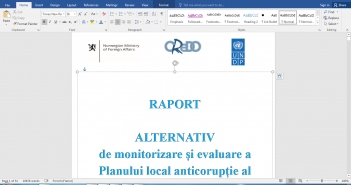Functional and Institutional Analysis of the Ministry of Health[EN]
Analiza Funcţională şi Instituţională a Ministerului Sănătăţii[RO]
Функциональный и институциональный анализ Министерства Здравоохранения[RU]
Functional and Institutional Analysis of the Ministry of Health
The report has
as its objective the functional and institutional analysis of the Ministry of
Health (MoH). This institutions human capital includes high competence needed
for the achievement of the institutions strategic objectives and later for the
performance of leadership by the MoH in the implementation of sector
objectives. The Ministrys human capital includes individual and team
capacities and skills; institutional capacities expressed through disaggregated
statistical information systems; analytical and qualitative technologies of
data interpretation in the process of developing policies and evaluating their
efficiency; knowledge and abilities of administration of policies and sector
institutions. The institutional capacities needed for the development of the
sector are as follows: existence of sector policy functions, regulatory
function (accreditation and inspection), support functions, including
investigation and collection of data necessary to other functions.
The findings of the report were periodically discussed during meetings with members of the working group, and its content is approved by a ministerial working group.
The report analyzes the systems and capacities from the perspective of their implementation within the MSPFC and the institutions of the sector. Constraints have been identified referring to the lack of some sector functions (the support function aimed at systematic collection of data and information relevant for policy processes), little use of statistical instruments for the assessment of needs and impact of policies, insufficient professional capacities within the Ministry and external constraints on the development of policy products. The Ministry is overburdened by a large number of petitions, while its role of managing the sector and the sector institutions represents an important challenge.
This report uses some methods of investigation and analysis of the situation. The main elements of functional analysis ensure identification of the detailed functions existing in the Ministry, the cost of functions in the Ministry, and quantification of products. The analysis of functional responsibilities, together with the in-depth study of the case studies on the Ministry’s main products give us the information needed to determine the existing and needed professional capacities. Another approach presents the method of analysis of the decision making with regard to policies. Decisional questionnaires, coupled with interviews of various ministerial actors, reveal the practice and the methods used in developing policy documents and offer the option of financial estimates of the cost in the process of development of policy documents. The specified methods were supplemented by some questionnaires, offering information on the organizational environment, communication and interaction within the Ministry. Finally, questionnaires on professional data, experience and competences are useful to understand the experience and competences of the Ministrys staff.
The report contains several chapters. The first chapter analyzes the Ministrys sector background: groups of beneficiaries, main policies, sector institutional structure, intra- and extra-sector relations. The second chapter contains the analysis of the Ministrys internal environment: quality of the decision making, cost of functions, organizational culture, institutional structure, productivity, and others. At the end of each chapter the conclusions of the analysis are systematized. Chapter 3 contains the analytical summary of findings and conclusions: SWOT analysis and analysis of the main problems from the perspective of Ministrys institutional development. At the end recommendations for the institutional strengthening of the Ministry are suggested.











